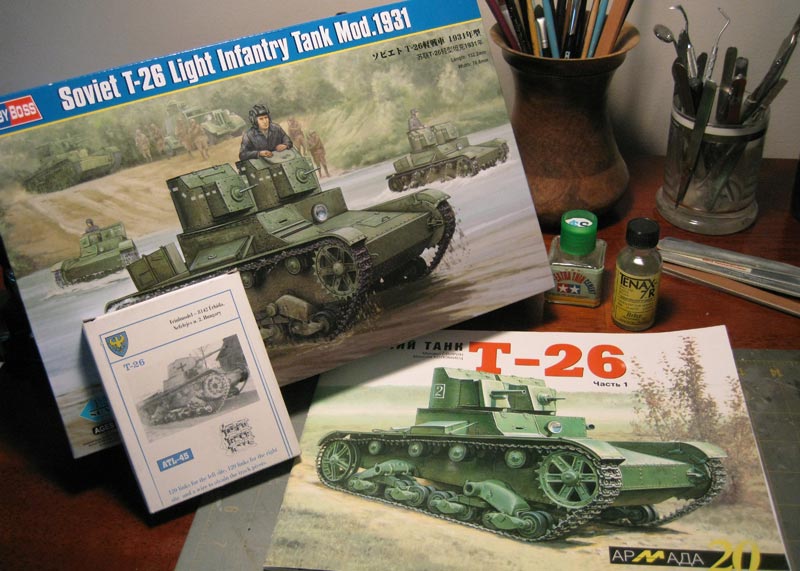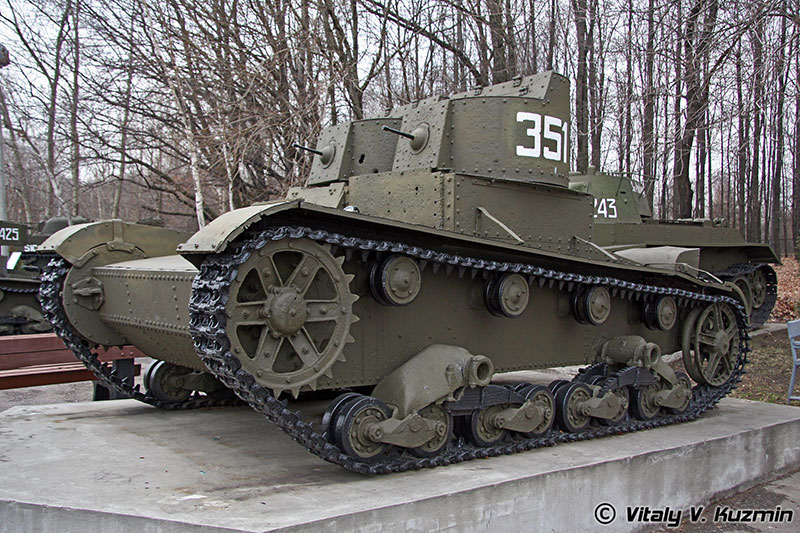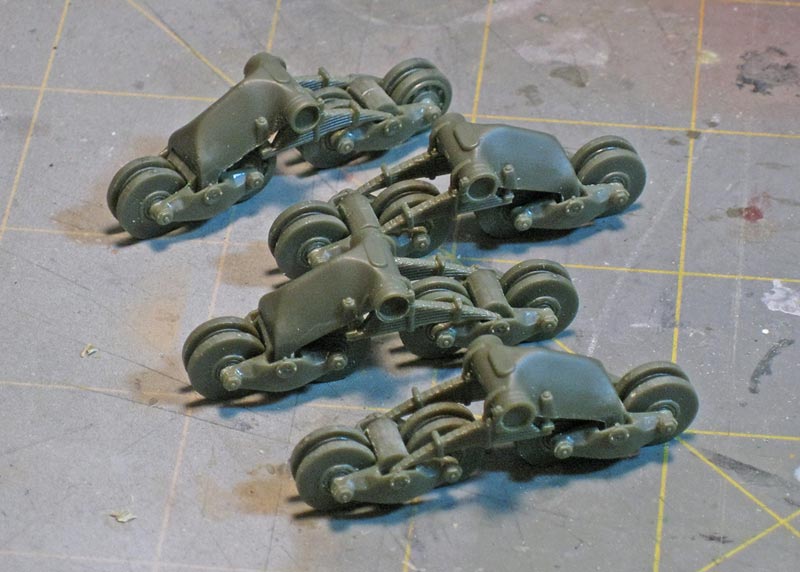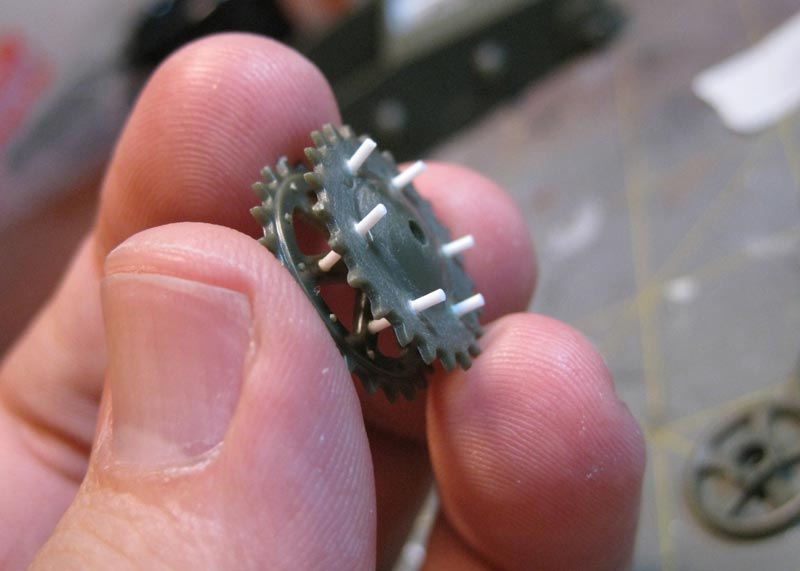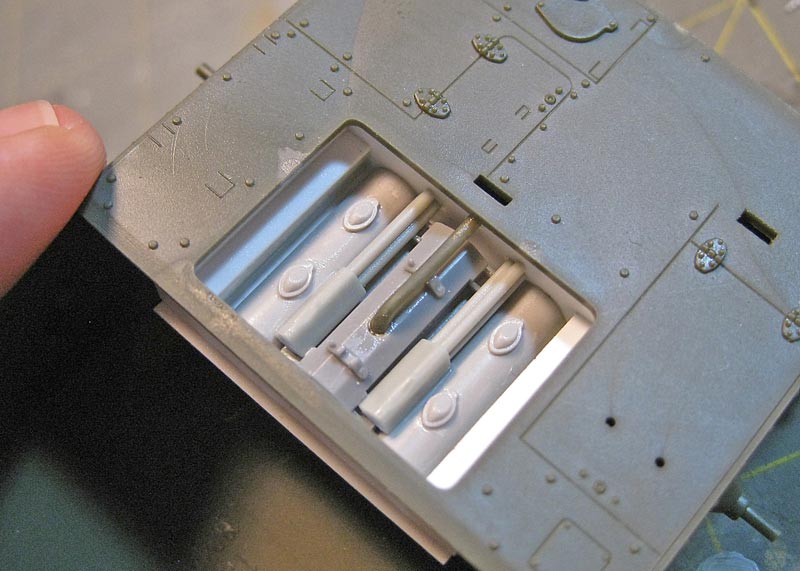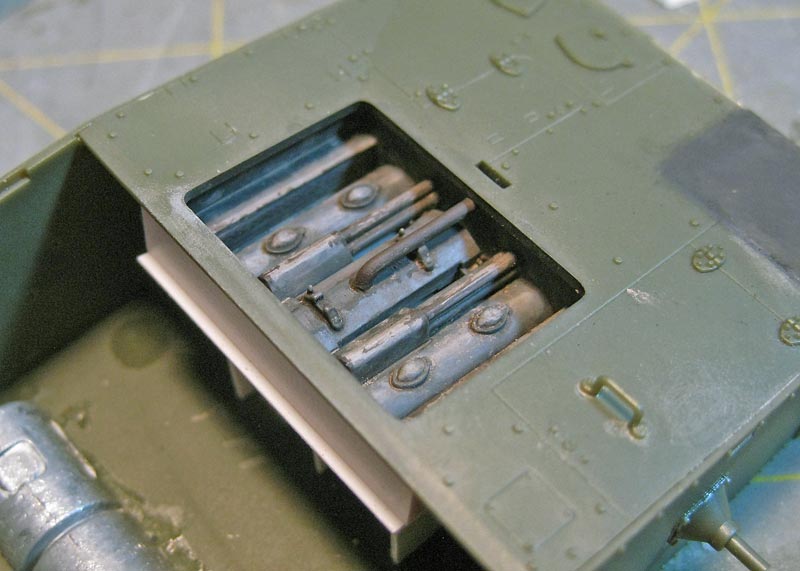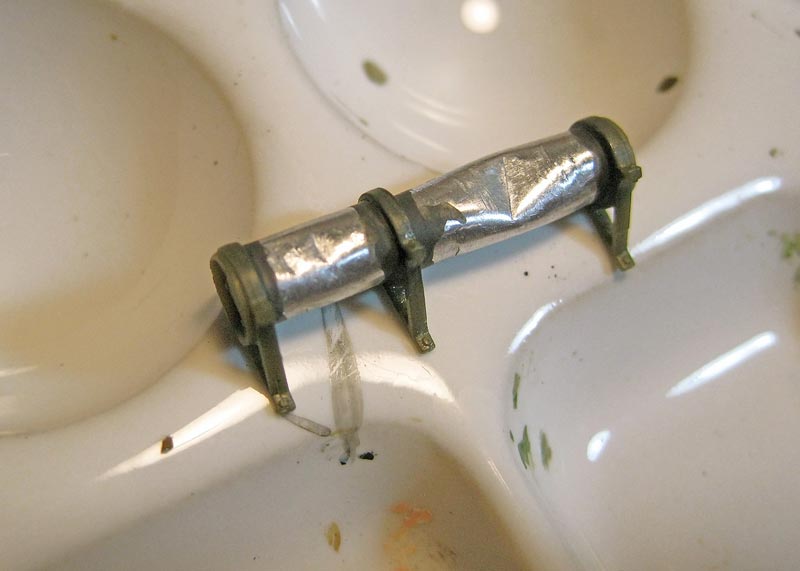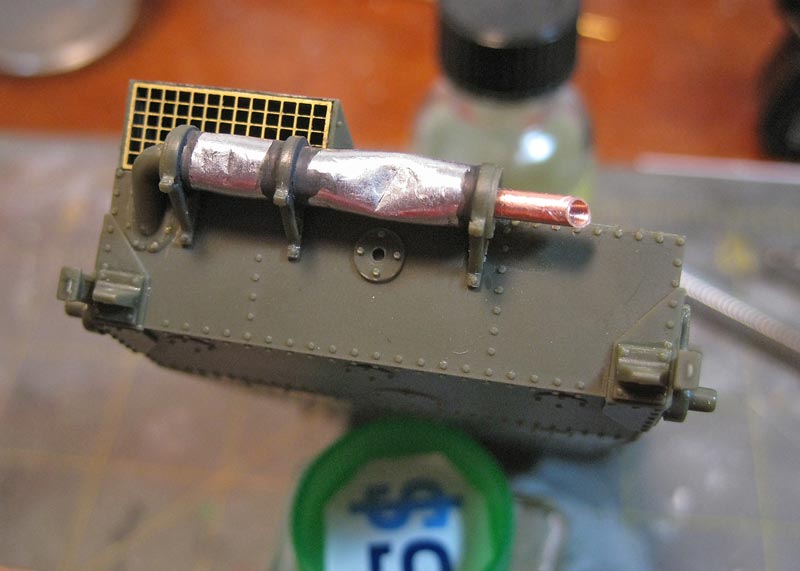Kansas, United States
Joined: October 09, 2005
KitMaker: 89 posts
Armorama: 85 posts
Posted: Thursday, October 17, 2013 - 06:42 AM UTC
Uusimaa, Finland
Joined: October 22, 2012
KitMaker: 1,194 posts
Armorama: 1,077 posts
Posted: Thursday, October 17, 2013 - 08:46 AM UTC
Nice work so far, I have this and the m1935 in the stash. Will be watching to see what's what.
Kimmo
There is a time to laugh and a time not to laugh, and this is not one of them.
Texas, United States
Joined: March 11, 2007
KitMaker: 977 posts
Armorama: 976 posts
Posted: Thursday, October 17, 2013 - 09:07 AM UTC
Very nice, especially the engine and beat up muffer. Model on.
Gregovich.
Gregovich "I paint all my Models in 4BO Green" Beckman
Holder of the Knight's Cross, Hero of the Soviet Union, Dragon Slayer and Slinger of Massive BS.
Kansas, United States
Joined: October 09, 2005
KitMaker: 89 posts
Armorama: 85 posts
Posted: Tuesday, October 29, 2013 - 08:40 AM UTC
Below is a pic of one kit side skirt. I wanted the option of easily adding battle damage. Adding general damage like bends and dings is difficult when working with thick plastic. Because of this I decided to scratchbuild two skirts from sheet plastic.
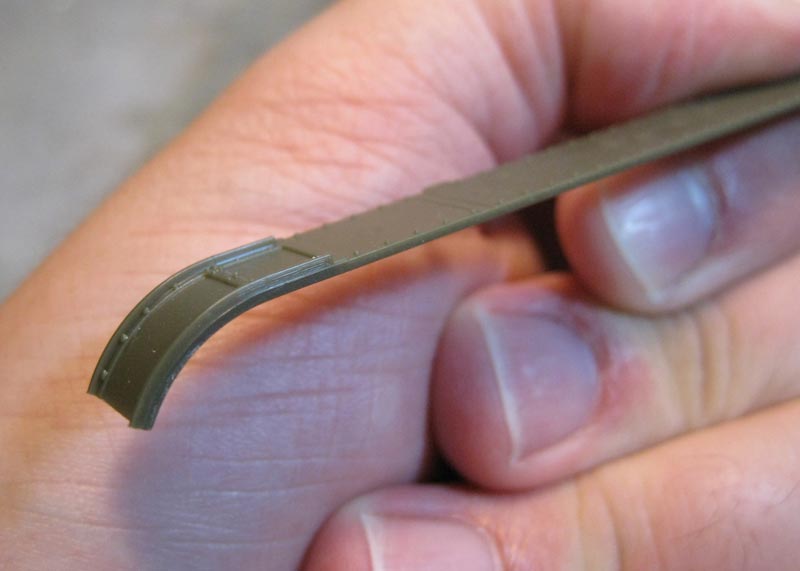
Illustrated below are pictures of the initial stages. 3mm is the distance between rivits that I settled on. After taping a plastic sheet to my cutting board I used the fine tip of a Bead Reamer to press rivets out of flat plastic. Here is the result.
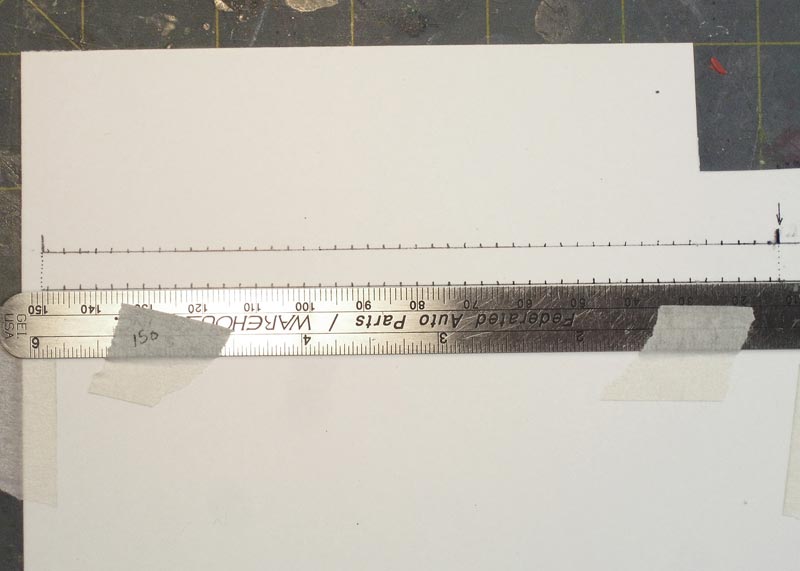
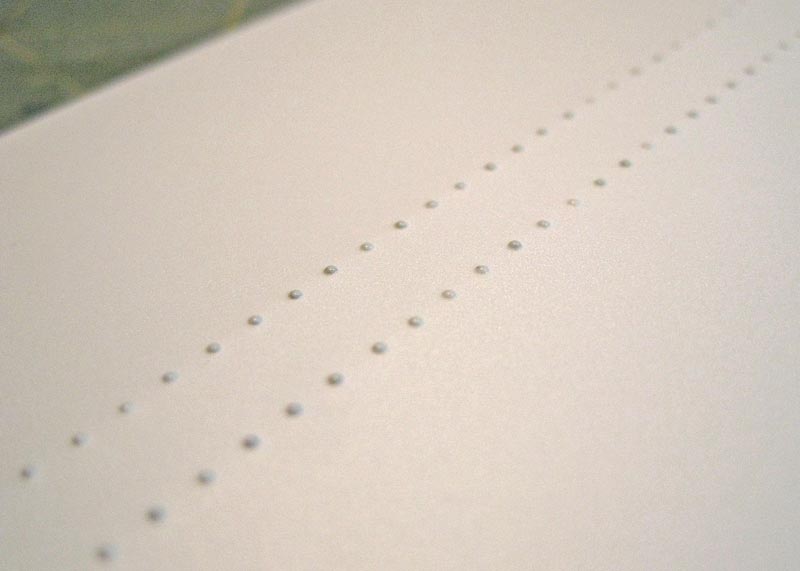

Photographed here includes the construction process involving the 'lip' of the skirts.
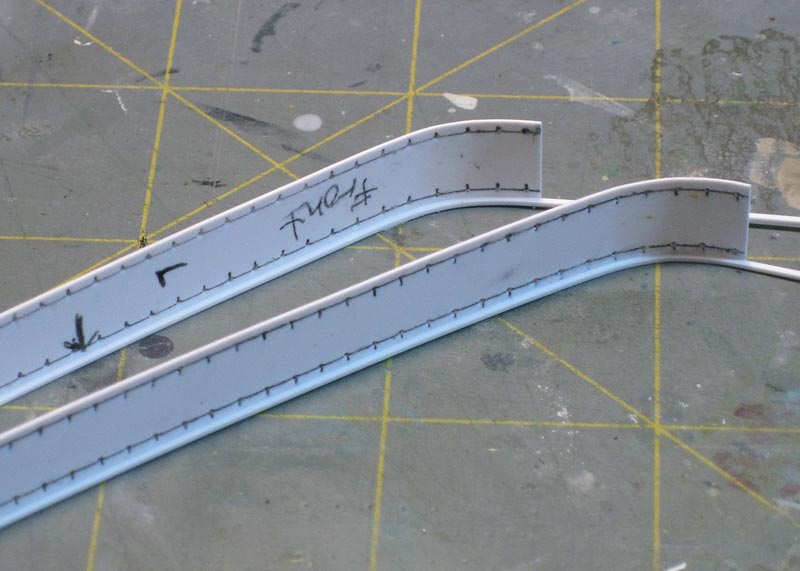
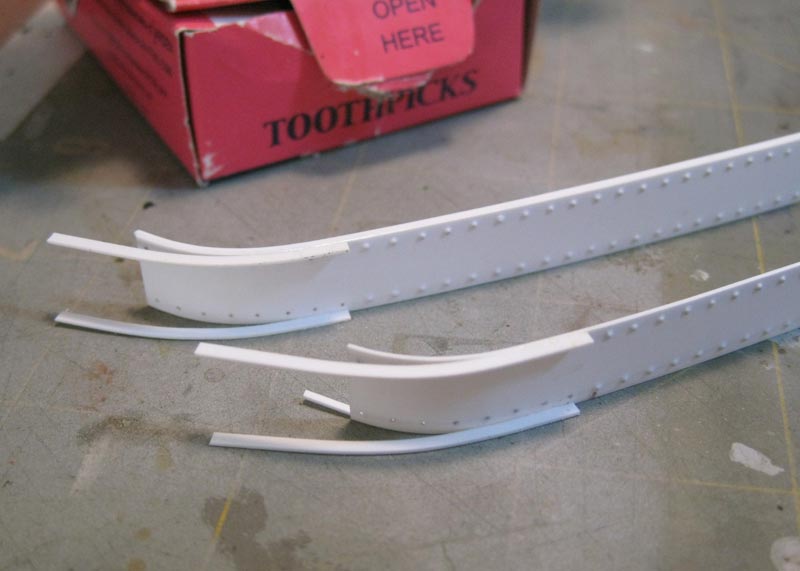
Overall I'm happy with the results. I must say the rivets are a bit out-of-scale. I'll easily give up scale innacuracies for ease of adding future battle damage, however. The next posting will have the skirts attached to the hull.
Louisiana, United States
Joined: March 06, 2010
KitMaker: 3,128 posts
Armorama: 2,959 posts
Posted: Tuesday, October 29, 2013 - 01:26 PM UTC
Paul;
Hi!
I'm watching this with some attention - I am thinking of buying one or another of these HB T-26 kits and need to see what-all I might be getting into!
I have a question about your bogie assemblies as shown in your third picture above:
It looks like you have two very different wheel-faces showing to the visible side of each pair - it looks like one wheel looks very much like both the art-work and the real deal photo - with distinct rim, bolt-heads, rubber tire - and the rest look, well, like the less-detailed sides of wheels some makers provide where they save detail work on the non-visible inner faces. I'm going to guess that all of these are actually just "dry-run" non-cemented bogie assemblies to show the look, and that you haven't somehow got many wheels flipped over?

In all other respects, the parts appear to have a lot of the apparent detail as seen on that real thing - looks to me like these T-26 kits could be a major jump ahead over the old Mirage/RPM vintage things.
Bob

Kansas, United States
Joined: October 09, 2005
KitMaker: 89 posts
Armorama: 85 posts
Posted: Wednesday, October 30, 2013 - 03:07 AM UTC
Bob,
Thanks for posting. That road wheel you're talking about is constructed from parts that are identified as non-use parts in the instructions. I used this wheel to add interest to the model. That wheel (bolts w/ rubber) is a later style of wheel used on this T-26 and later variants. Only enough for two wheels where included to make these rubber style road wheels. This kit only supplied the all-metal kind for construction.
There are some B&W photographs that show a mixture of wheel styles. I added mine to suggest a field repair. You can *just* barley see the other one on the same bogie...
This kit is well made. However, I suggest buying an aftermarket track set because the one included is over-engineered (3 pieces per link!). A photoetch set that's available will help out the skirts if desired. I choose to scratchbuild mine because I didn't want to spend $45 and wait a full week for arrival.
New Jersey, United States
Joined: March 15, 2002
KitMaker: 1,745 posts
Armorama: 1,483 posts
Posted: Wednesday, October 30, 2013 - 03:12 AM UTC
Actually the roadwheels you are using are nearly all rubber, which is why they replaced them...they chunked up really easily and generally didn't hold up that well.
Kansas, United States
Joined: October 09, 2005
KitMaker: 89 posts
Armorama: 85 posts
Posted: Wednesday, October 30, 2013 - 03:41 AM UTC
... I don't know. With these 75 year old tanks accurate resources are limited. That book written in all-Russian photographed above shows all-metal wheels in early models while later variants start to have the rubber kind introduced.
New Jersey, United States
Joined: March 15, 2002
KitMaker: 1,745 posts
Armorama: 1,483 posts
Posted: Wednesday, October 30, 2013 - 04:09 AM UTC
Quoted Text
... I don't know. With these 75 year old tanks accurate resources are limited. That book written in all-Russian photographed above shows all-metal wheels in early models while later variants start to have the rubber kind introduced.
Ok seems to be misunderstanding here, I'll explain:

If you look at the photo above, in the "middle" of the suspension, there are two different road wheels. The front of the rear suspension unit has the older all-rubber (not steel) style roadwheel, while the rest of it has the newer roadwheels that have more metal to them and less of a rubber lip on them.
The Hobbyboss kit (actually all of the hobbyboss releases have this style roadwheel) has the all-rubber roadwheel on it. This style roadwheel was first fitted to the T-26, then phased out as time went on due to poor performance, with the newer style wheel that is shown above.
The Soviets had pretty terrible logistical support in 1930s and at the start of the WW2...so basically there was no spare parts and when a vehicle crapped out, it was basically rebuilt, and when the older vehicles came in, they replaced the roadwheels with the newer ones.
Kansas, United States
Joined: October 09, 2005
KitMaker: 89 posts
Armorama: 85 posts
Posted: Wednesday, October 30, 2013 - 04:23 AM UTC
Scott,
Thanks for the clarification. While you were posting I did some image search an I did find these "metal" wheels were chipped like rubber in some B&W photos. Huh, for the longest time I thought these were solid metal. Guess I'll need to paint these accordingly later (and also take some chips out). I appreciate your input.
Paul
New Jersey, United States
Joined: March 15, 2002
KitMaker: 1,745 posts
Armorama: 1,483 posts
Posted: Wednesday, October 30, 2013 - 05:07 AM UTC
No problem, I'm working on a PowerPoint explaining the different T-26s and which hobby kits to use to build them
Wisconsin, United States
Joined: June 16, 2008
KitMaker: 418 posts
Armorama: 408 posts
Posted: Wednesday, October 30, 2013 - 05:31 AM UTC
T-26 engine cylinders were located horizontally, so from the top it would look like that:

Here is the overall view of the engine:

Quoted Text
The Soviets had pretty terrible logistical support in 1930s and at the start of the WW2...so basically there was no spare parts and when a vehicle crapped out, it was basically rebuilt ...
And your conclusions based on...?
New Jersey, United States
Joined: March 15, 2002
KitMaker: 1,745 posts
Armorama: 1,483 posts
Posted: Wednesday, October 30, 2013 - 05:53 AM UTC
Quoted Text
The Soviets had pretty terrible logistical support in 1930s and at the start of the WW2...so basically there was no spare parts and when a vehicle crapped out, it was basically rebuilt ...
And your conclusions based on...?[/quote]
The T-26 along with the BT series just about ceased to exist on the Eastern Front by the end of 1941.
I took this out of Cookie's article on the T-26 he did awhile ago for Military Modelling
Quoted Text
But there was a slight problem, as not all of these tanks on hand were functional due to wear, breakdowns, maintenance problems or simply age. Beginning in April 1940 the RKKA had established five equipment status categories for reporting:
Category 1 – new equipment, not previously in use, fully ready for operation and technically acceptable;
Category 2 – in service, fully ready for operation, may need normal repairs or servicing (author’s italics);
Category 3 – items requiring district workshop level repairs or maintenance;
Category 4 – items requiring central workshop or production factory repairs;
Category 5 – unserviceable items.
As of 1 June 1941, there were 4,875 T-26s of all categories in the western military districts of the USSR – roughly one-half of all of them built. 828 were listed as Category 1, 3,339 in Category 2, 709 were listed as non-operational due to being in Category 3 or 4, and none in Category 5. But of that Category 2 number, it is not known how many were actually functional. 30% may have been early models (e.g pre-1934 construction) and having only limited service life left, and many others may have been inoperable due to dead batteries, missing track links, broken suspension units, and many other items considered “troop-level” maintenance and repair items.
Uusimaa, Finland
Joined: October 22, 2012
KitMaker: 1,194 posts
Armorama: 1,077 posts
Posted: Wednesday, October 30, 2013 - 06:19 AM UTC
Quoted Text
Actually the roadwheels you are using are nearly all rubber, which is why they replaced them...they chunked up really easily and generally didn't hold up that well.
Were there actually 3 types as per
http://www.andreaslarka.net/T-26_details/T-26_details.html (scroll down) or do those all metal ones just have the rubber worn off or removed?
Kimmo
There is a time to laugh and a time not to laugh, and this is not one of them.
New Jersey, United States
Joined: March 15, 2002
KitMaker: 1,745 posts
Armorama: 1,483 posts
Posted: Wednesday, October 30, 2013 - 06:22 AM UTC
Quoted Text
Quoted Text
Actually the roadwheels you are using are nearly all rubber, which is why they replaced them...they chunked up really easily and generally didn't hold up that well.
Were there actually 3 types as per http://www.andreaslarka.net/T-26_details/T-26_details.html (scroll down) or do those all metal ones just have the rubber worn off or removed?
Kimmo
They look like they are the rubber type without the rubber on them
I have some photos in book I have showing damage to the rubber roadwheels, I'll scan them in.
Uusimaa, Finland
Joined: October 22, 2012
KitMaker: 1,194 posts
Armorama: 1,077 posts
Posted: Wednesday, October 30, 2013 - 06:54 AM UTC
Quoted Text
Quoted Text
Quoted Text
Actually the roadwheels you are using are nearly all rubber, which is why they replaced them...they chunked up really easily and generally didn't hold up that well.
Were there actually 3 types as per http://www.andreaslarka.net/T-26_details/T-26_details.html (scroll down) or do those all metal ones just have the rubber worn off or removed?
Kimmo
They look like they are the rubber type without the rubber on them
I have some photos in book I have showing damage to the rubber roadwheels, I'll scan them in.
That's what I thought, thanks.
Kimmo
There is a time to laugh and a time not to laugh, and this is not one of them.
New Jersey, United States
Joined: March 15, 2002
KitMaker: 1,745 posts
Armorama: 1,483 posts
Posted: Wednesday, October 30, 2013 - 06:58 AM UTC
Hmmm I was just doing some more research, and its possible that their might be a 3rd set of roadwheel design like shown in your photo...I've seen a few photos of the Vickers 6 Ton with this style of roadwheel. IIRC Finland did receive a couple Vickers Tanks, along with the captured Russian ones...
Looks like the wheel was fitted at the last roadwheel station


Uusimaa, Finland
Joined: October 22, 2012
KitMaker: 1,194 posts
Armorama: 1,077 posts
Posted: Wednesday, October 30, 2013 - 09:20 AM UTC
Quoted Text
Hmmm I was just doing some more research, and its possible that their might be a 3rd set of roadwheel design like shown in your photo...I've seen a few photos of the Vickers 6 Ton with this style of roadwheel. IIRC Finland did receive a couple Vickers Tanks, along with the captured Russian ones...
Looks like the wheel was fitted at the last roadwheel station


Finland had a few in service, they may have also gotten spare parts through the Germans from Polish stocks. I love opening cans of worms

And apologies to Paul if we're going slightly off topic and threadjacking his build.
Kimmo
There is a time to laugh and a time not to laugh, and this is not one of them.
Kansas, United States
Joined: October 09, 2005
KitMaker: 89 posts
Armorama: 85 posts
Posted: Wednesday, October 30, 2013 - 10:31 AM UTC
No worry guys. Go ahead ad use this thread for any sort of discussion related to modeling a T-26. Without the input from you fellas I would've painted my road wheels incorrectly thinking they were metal and not rubber.
Uusimaa, Finland
Joined: October 22, 2012
KitMaker: 1,194 posts
Armorama: 1,077 posts
Posted: Wednesday, October 30, 2013 - 10:58 AM UTC
Quoted Text
No worry guys. Go ahead ad use this thread for any sort of discussion related to modeling a T-26. Without the input from you fellas I would've painted my road wheels incorrectly thinking they were metal and not rubber.
Glad to hear. I asked over on a Finnish site to see if we might get an answer on what the deal is with that third type of road wheel. Hopefully I'll hear something tomorrow.
Kimmo
There is a time to laugh and a time not to laugh, and this is not one of them.
Louisiana, United States
Joined: March 06, 2010
KitMaker: 3,128 posts
Armorama: 2,959 posts
Posted: Wednesday, October 30, 2013 - 12:46 PM UTC
Paul;
Thanks for the clarification on your wheels.
I confess to being somewhat disappointed to see that HB has "advertised" via their box art that this kit has the "less rubber" bolted later pattern wheels that are much more frequently seen in pictures of these T-26 variants - but supplies the much less detailed (and less appealing, IMO) "more rubber" early-pattern wheels. From what I've read today in various web reviews, etc., these same "more rubber" types are to be found in maybe all of the HB T-26 series. Too bad!
Frankly, this finding takes away some of my enthusiasm for getting one of these. (It's not any reflection on your build, BTW, which looks great, nor any claim or suggestion on my part that the kit wheels are actually "wrong" (seems others have identified the multiple patterns available and yours appear to be those earlier pattern wheels), but just a possibly childish and peevish reaction I have to model companies "advertising" features that are not actually provided in their boxes!

)
Model on. I am positive that your build will come out looking great!

Bob

Wisconsin, United States
Joined: June 16, 2008
KitMaker: 418 posts
Armorama: 408 posts
Posted: Wednesday, October 30, 2013 - 04:00 PM UTC
Quoted Text
But there was a slight problem, as not all of these tanks on hand were functional due to wear, breakdowns, maintenance problems or simply age. Beginning in April 1940 the RKKA had established five equipment status categories for reporting:
Category 1 – new equipment, not previously in use, fully ready for operation and technically acceptable;
Category 2 – in service, fully ready for operation, may need normal repairs or servicing (author’s italics);
Category 3 – items requiring district workshop level repairs or maintenance;
Category 4 – items requiring central workshop or production factory repairs;
Category 5 – unserviceable items.
Interesting... I have a bunch of scans of Soviet documents of that time, but I don't remember any of them placing vehicles in such categories. Will need to ask Steve on his source.
New Jersey, United States
Joined: March 15, 2002
KitMaker: 1,745 posts
Armorama: 1,483 posts
Posted: Wednesday, October 30, 2013 - 11:23 PM UTC
Quoted Text
Quoted Text
But there was a slight problem, as not all of these tanks on hand were functional due to wear, breakdowns, maintenance problems or simply age. Beginning in April 1940 the RKKA had established five equipment status categories for reporting:
Category 1 – new equipment, not previously in use, fully ready for operation and technically acceptable;
Category 2 – in service, fully ready for operation, may need normal repairs or servicing (author’s italics);
Category 3 – items requiring district workshop level repairs or maintenance;
Category 4 – items requiring central workshop or production factory repairs;
Category 5 – unserviceable items.
Interesting... I have a bunch of scans of Soviet documents of that time, but I don't remember any of them placing vehicles in such categories. Will need to ask Steve on his source.
Its from Cookie Sewell...his T-28/35 article has the same information on that vehicle also.
From what I understand, the Soviets had lots of tanks in the 1930's but really didn't develop a logistical tail to support them properly...seems like they basically used them up and then rebuilt them, instead of maintaining them. They had huge numbers of stuff, but where lucky to have half of it fully operational.
Kansas, United States
Joined: October 09, 2005
KitMaker: 89 posts
Armorama: 85 posts
Posted: Thursday, October 31, 2013 - 04:00 AM UTC
Bob,
I totally get why you're not as excited about this kit anymore. However, I think you should still keep this on your to-build list. Some assemblies are a little over (and under) engineered - but other than that this is a fun build. This kit can be a quick month-long build or you can constantly improve it during a marathon project. Those all-rubber wheels can be chipped and weathered enough to kind of makeup for your desire for the less rubber kind.
Uusimaa, Finland
Joined: October 22, 2012
KitMaker: 1,194 posts
Armorama: 1,077 posts
Posted: Thursday, October 31, 2013 - 07:31 AM UTC
Starting to get some replies of sorts from the Finnish guys. It is looking like the all metal road wheel in the link I posted earlier is probably from a Vickers. Someone mentioned that the Soviets had an all metal road wheel too. No source or citation, so take it with a grain of salt. I guess we'll need to take a closer look at period photos to see what's up.
Kimmo
There is a time to laugh and a time not to laugh, and this is not one of them.
